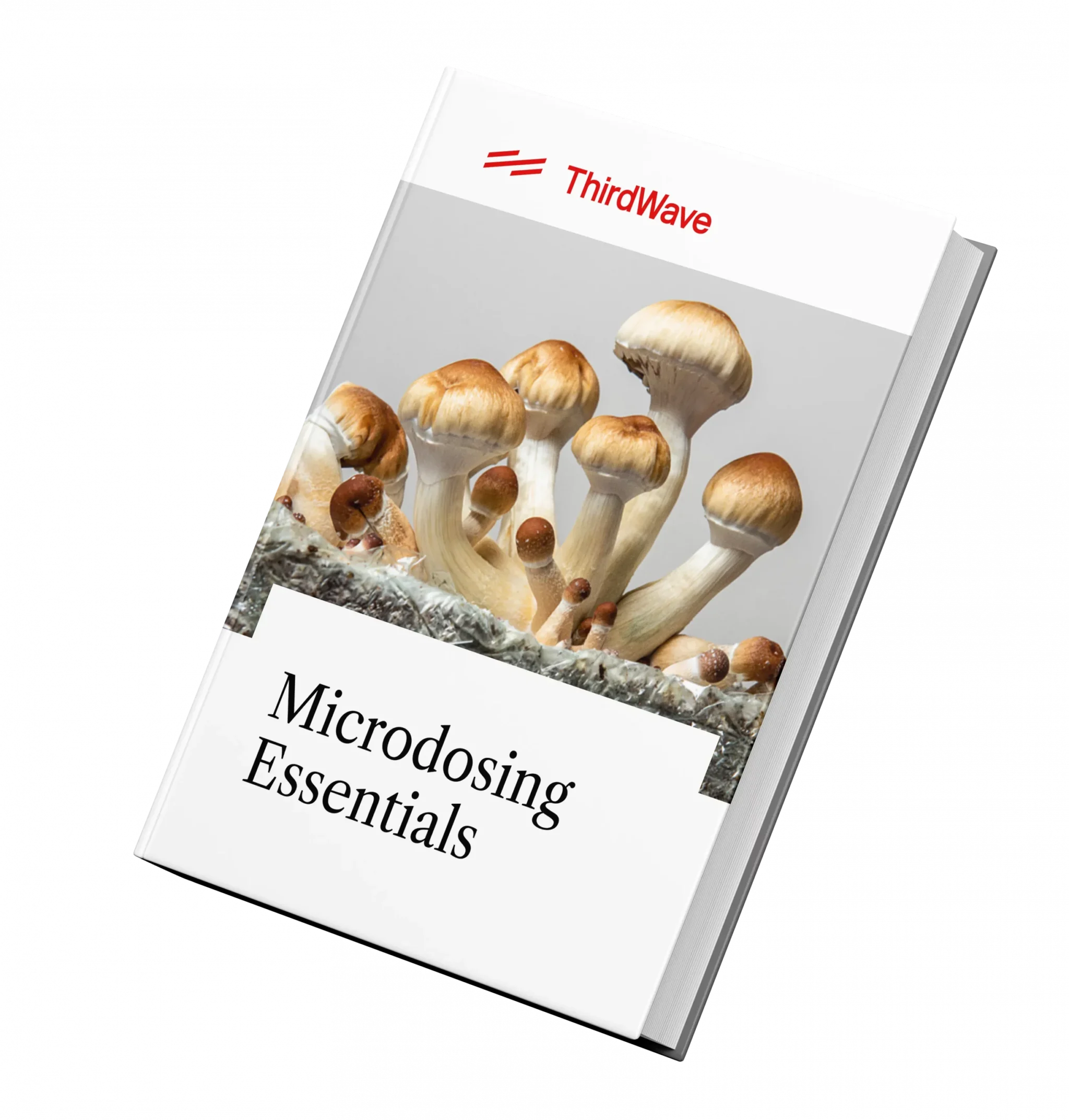The Ultimate Guide to
Tobacco
Ciggies, darts, durries, rollies, smokes, fags, butts, cancer sticks
Tobacco is a largely legal substance, though highly regulated in many countries. We do not encourage or condone its use where it is against the law. While many studies have shown negative health consequences to tobacco consumption, we believe that offering responsible harm reduction information is imperative to keeping people safe. For that reason, this guide is designed to enhance the safety of those who decide to work with tobacco.
Tobacco is one of the most widely used psychoactive plants on the planet, with a rich history and dynamic narrative. It is made from the leaves of plants from the genus Nicotiana, native to North and South America and Australia. The most well-known species are Nicotiana rustica and Nicotiana tabacum. While traditionally used as an offering, for blessings, and for intentional ingestion as part of spiritual practices, tobacco has been largely commercialized in the modern Western world, where it is sold as cigarettes, snuff, or chewing tobacco. In this context, tobacco has come to be known as an addictive, high-risk substance. Yet, in many parts of the world, it remains a medicinal plant and an essential part of spiritual practices. Tobacco smoke is used to cleanse, protect, and carry intention. Through this guide, we aim to reframe tobacco and support and encourage education around the intentional use of this plant.
Overview
01Tobacco has a long history; its use stretches back possibly thousands of years. Following its introduction into Europe and Asia, it was widely adopted by a variety of communities worldwide. It is often consumed as cigarettes, cigars, or snuff. When used recreationally, tobacco is considered a stimulant and anxiolytic, creating a sense of well-being and mild euphoria. It is commonly known as a legal and socially accepted drug in the same sense as caffeine.
“Tobacco” is the common name for various products made from the leaves of various plants of the genus Nicotiana. Nicotiana is a member of Solanaceae (the nightshade family), which includes economically important plants such as tomatoes, potatoes, eggplant, chili, and capsicum. This group also includes powerful Amazonian medicine plants such as Datura and Brugmansia (both referred to as toé), and Brunfelsia, which is known as chiric sanango.
The main cultivated species of tobacco are N. tabacum and N. rustica. Its extended use has resulted in a variety of ways to consume it. Commercially available tobacco products include a range of tailor-made cigarettes, pouches of finely cut cured tobacco leaf for “roll your own” cigarettes, and tobacco leaves rolled into cigars of varying sizes, including expensive products such as Havana cigars from Cuba. Other forms of prepared tobacco include chewing tobacco and tobacco snuff. Tobacco is commonly used to mix with cannabis flowers or hashish for flavor and increased flammability. Some ornamental varieties, such as Nicotiana sylvestris, are widely cultivated but cannot be consumed as tobacco due to their toxicity.
In parts of South America, tobacco is treated as a medicine. An essential aspect of Amazonian curanderismo is that you cannot talk about ayahuasca without talking about tobacco, as Jeremy Narby recently explored in his new book, Plant Teachers. Check out the Third Wave podcast episode where Paul F. Austin interviews Narby about ayahuasca and tobacco. When walking the markets in towns well-known for ayahuasca, such as Iquitos, Cusco, or Pucallpa, numerous stalls sell a variety of herbs, including ceremonial tobacco and thick rolled cigarettes of mapacho tobacco. Tobacco is intimately linked to ceremonial use regardless of the traditional ways it is used, whether ingested as smoke, tea, or an enema.
Beyond its spiritual use, tobacco leaves also serve a purpose in traditional ways of gardening. In fact, ground up and soaked tobacco leaves result in a powerful insecticide and will also keep larger critters from damaging your plants [2].
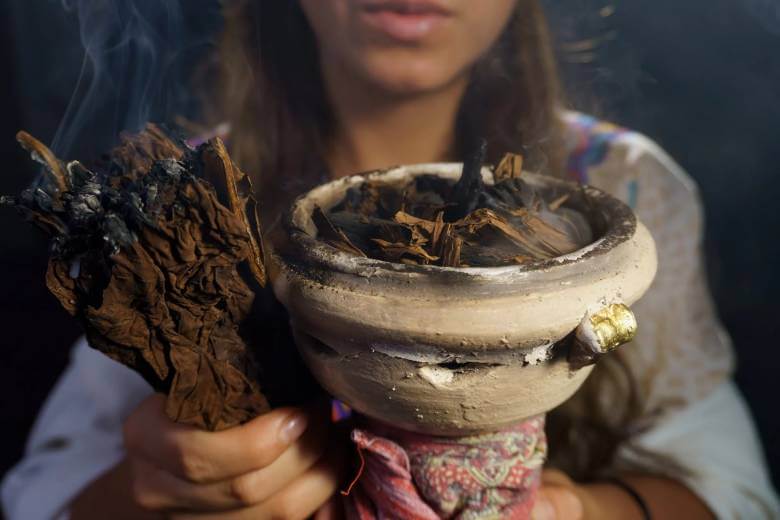
History
02Cultivation of tobacco dates back to as early as 5000–3000 BC in Central and South America. Smoking in the Americas is thought to have its origins in ceremonies involving the burning and smudging of various plant leaves, such as sage and other aromatic plants. It may then have been adopted for ceremonial purposes and within the rituals of curandero/curanderas to achieve trances and access to the spirit world.
After Columbus returned with tobacco from his second trip to the New World, tobacco was introduced to Europe. Less than a hundred years after its introduction into Europe, tobacco had traveled widely, even as far as Siberia, where small packets of tobacco were being placed into the graves of shamans.
The genus Nicotiana, as well as nicotine, was named after Jean Nicot, the French ambassador to Portugal. In 1559 he sent tobacco as a medicine to the court of Catherine de’ Medici.[14]
Native American use of tobacco
Many First Nations Peoples of North America believe tobacco was the first plant given to them by the Creator. That’s specifically true for the Ojibwe, who consider tobacco (asemaa) one of the four sacred medicines gifted by Gichi-manidoo.
In Ojibwe tradition, tobacco is smoked in ceremonial pipes to facilitate sacred ceremonies or seal bargains. Its smoke is believed to carry one’s thoughts and prayers to heaven. Additionally, it is regarded as the activator of all the plant spirits, as it represents all aspects of the spirit. Three other plants—sage, cedar, and sweetgrass—are also regarded as sacred, and together these plants are referred to as the Four Sacred Medicines, although the phrase “always through tobacco” shows the essential role tobacco plays.
Tobacco also plays an important role in Native American sweat ceremonies. These are held in a sweat lodge, a domed circular structure, which is usually a teepee or a pit covered with branches. Directly outside the structure, a fire is lit and a firekeeper heats the stones that are used to keep the lodge hot. The stones are placed in a hole in the center of the lodge; tobacco, cedar, or sweetgrass are then added as an offering. Thick steam is created by pouring water over the rocks while prayers are offered.
Tobacco is often mixed with other herbs; in North American traditions, this can include red willow. The Lakota mix their tobacco with the sweet and “woodsy” smelling red willow bark, which, despite the name, is the bark of the red osier dogwood (Cornus stolonifera). Known as “cansasa”, red willow is a spiritually important herb and is often used during times of ceremony to show respect or give spiritual protection. When smoked in a sacred pipe, the mixture has been used to end conflicts between individuals or seal agreements between leaders of different groups.
How was it used medicinally?
While principally used as an offering and for smoking, tobacco was also used as a medicine. For example, it was used as a painkiller for treating earache and toothache. Smoking tobacco is said to be a cure for many complaints, including colds. Tobacco was mixed with the leaves of the small desert sage, Salvia dorrii, or the root of Indian balsam or cough root, Leptotaenia multifida, the addition of which was thought to be particularly good for asthma and tuberculosis.[3]
South American use of tobacco
In South America, tobacco is revered as one of the master teacher plants. Of the plant medicines, tobacco is one of the most sacred; for some, it is even more important than ayahuasca. Curandero/curanderas consume tobacco in many different ways: as cigarettes, using a specially carved sacred pipe, or as tea. Tobacco may also be used as an additive in ayahuasca.
Nicotiana rustica is the tobacco used in the Amazon. It is a potent tobacco considered to have powerful healing qualities, used for deep cleansing, to help ground, and to facilitate clarity. It is smoked as cigarettes, in hand-rolled white paper, or in sacred pipes. The role of a tobaquero/tobaquera—a tobacco curandero/curandera—is to pray over the tobacco in ceremonies where a strong tobacco brew is drunk. In this case, the tobacco does not work as an entheogen but to cleanse the body of toxins and negative energy, facilitating communication via intuition and dream space.
Tobacco is often part of the dieta, which is a set period in which the participant uses master plants for healing. Through a deep and intentional relationship with tobacco, the curandero/curandera communicates with the plant spirit. Practitioners drink it to deeply cleanse the body and carry intentions for healing into their body and psyche.
Modern use of tobacco
Smoking as a way of ingesting plant material was only introduced into Europe when Columbus returned with tobacco from his second trip to the New World. Although it is known that many ancient civilizations—including the Babylonians, the Indians, the Chinese, and Christians in Europe—had burnt incense during religious rituals, it had never evolved into smoking.
Beyond LSD and Psilocybin is a field. This guide will take you there.
In Third Wave’s Ultimate Guide to Safely Sourcing Psychedelics, you will discover an astonishing menu of psychedelic medicines…
…and how to source them without legal risk.

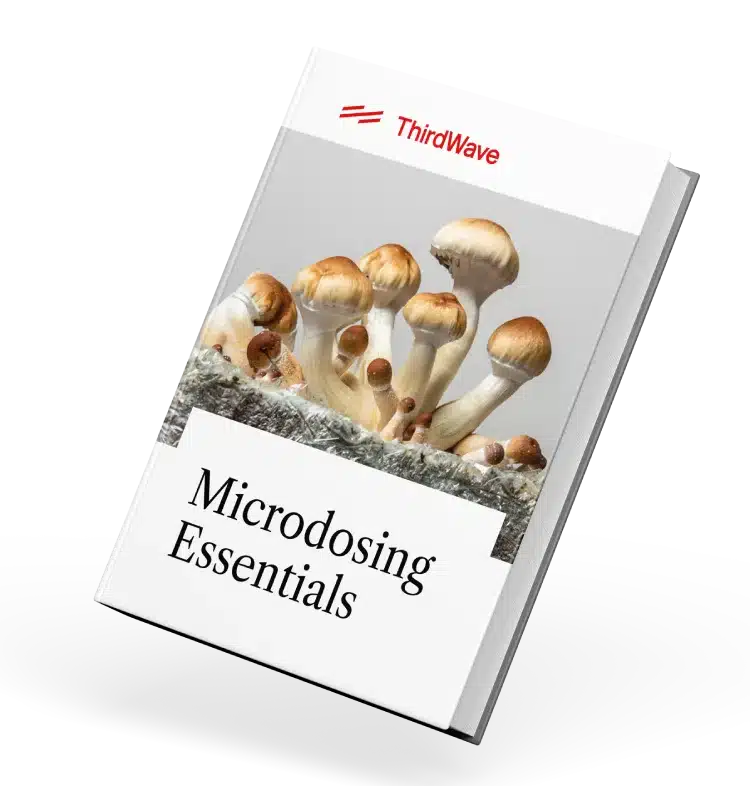
Beyond LSD and Psilocybin is a field. This guide will take you there.
In Third Wave’s Ultimate Guide to Safely Sourcing Psychedelics, you will discover an astonishing menu of psychedelic medicines…
…and how to source them without legal risk.
Experience
03What to Expect
The main active compound in tobacco is nicotine. Tobacco smoked as a cigarette has subtle effects; it contains little nicotine. Still, for those new to tobacco, until tolerance is acquired, they can experience very unpleasant side effects, including nausea and dizziness [4]. Nicotine is classified as a stimulant, although the stimulatory effects are subtle compared to other stimulants such as caffeine or amphetamines.
There is a slight, brief high at low doses resulting from the release of endorphins. There is also an increase in dopamine levels. The effects of low amounts of nicotine wear off quickly. However, nicotine inhibits nerve transmission at higher doses, resulting in moderate sedative effects. Nicotine is known to cause decreased appetite, heightened mood, increased heart rate and blood pressure, nausea, diarrhea, better memory, and increased alertness.
Tobacco is usually inhaled in short puffs, which produces the stimulant effect from nicotine by enhancing the action of norepinephrine and dopamine. Conversely, there is a unique biphasic effect [4], where breathing in deep breaths produces a sedative through the release of β-endorphin (which reduces anxiety) and enhances the action of serotonin and opioids (which causes sedation). Mapacho, as a much stronger tobacco (up to 14% nicotine), can result in a very strong, even overwhelming nicotine effect. Some describe the experience as simultaneously firing and burning synapses wildly.
Hapé/rapé (pronounced “ha-peh” or “rapay”) is a type of tobacco from South America, where tobacco ash is mixed with herbs. The powder is administered nasally via a specially designed pipe. Some pipes are designed for the hapé /rapé to be administered by another person, while other pipes are designed for self-administration. Hapé/rapé tends to be consumed in medium or strong doses, producing a strong effect that may include watery eyes, dizziness, nausea, deep connectedness, and powerful feelings.
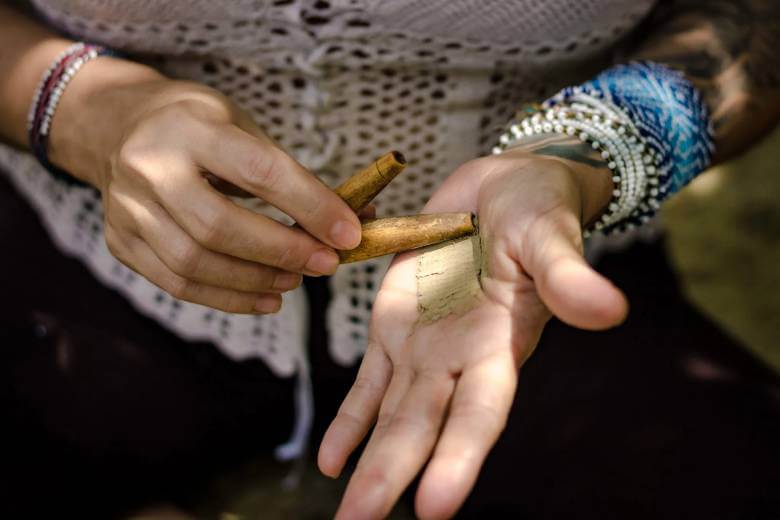
Pharmacology
Nicotiana spp. contain many alkaloids, but the principal active compound present in tobacco is the alkaloid Nicotine [3-[(2S)-1-methylpyrrolidin-2-yl]pyridine; I -methyl-2-(3-pyridyl) pyrrolidine], a naturally-occurring stimulant of the pyridine and pyrrolidine class of compounds. Nicotine acts as a receptor agonist at most nicotinic acetylcholine receptors (nAChRs).[5] It also acts as a receptor antagonist at the nicotinic receptor subunits (nAChRα9 and nAChRα10). Nicotine produces its stimulating effects by prompting the liver to release glucose and the adrenal medulla to release epinephrine (adrenaline).
When inhaled, nicotine reaches the brain within 10-20 seconds. It is absorbed through the lungs, distributed quickly through the bloodstream, and crosses the blood-brain barrier. The majority of the psychoactive effects are caused by the release of many neurotransmitters and hormones, including acetylcholine, norepinephrine, epinephrine, arginine vasopressin, serotonin, dopamine, and β-endorphin. [6][7] The half-life of nicotine is approximately two hours and it is primarily excreted in the urine.
In N. tabacum, nicotine is present in concentrations as high as 3% in the dried leaves [8]; in N. rustica it exists in even higher concentrations, up to 14%.
Toxicity
The toxicity of tobacco is based on how it is consumed. Except where a person may have a low tolerance to nicotine, overdose is unlikely. The toxic effects are due to nicotine, which has a relatively high toxicity. The median lethal dose of nicotine in humans is unknown [9][10], but the estimated lower dose for fatal outcomes is 500–1,000 mg for an adult, or 6.5–13 mg/kg. [11]
Lethal nicotine poisoning rapidly produces seizures and death due to respiratory paralysis, which may occur within minutes.
Symptoms of nicotine overdose typically include nausea, vomiting, diarrhea, hypersalivation, abdominal pain, rapid heart rate, high blood pressure, rapid breathing, headache, dizziness, pallor (pale skin), auditory or visual disturbances, and perspiration, followed shortly by marked bradycardia (slow heart rate), slow breathing, and low blood pressure. One of the primary signs of nicotine poisoning is rapid breathing. At very high doses, symptoms include sleepiness or drowsiness, confusion, loss of consciousness, shortness of breath, marked weakness, seizures, and coma.[12]
Dosing
Unless you are consuming a commercial product, the dosage of any tobacco product may be hard to judge. An individual aiming to use tobacco in a ceremonial context may choose to use loose leaf organic tobacco rolled in organic hemp papers. When rolling your own product, however, the dosage will inevitably vary from a standardized cigarette. If you are pursuing an alternative to commercial products, then it is important to be aware of how much you’re consuming. As with many substances, the recommendation is to start low and work up. Dosage will also depend on how you are consuming the product, particularly with inhalation. In time, tolerance is developed. Beginner smokers may feel irritation in the throat and lungs, but in time they become accustomed to this. To be clear, this does not mean that the smoke is no longer aggravating your respiratory system (because it is), but your body has simply adapted to the stressor. To minimize harm to your system, it’s best to use tobacco for infrequent ceremonial purposes only. You should also be aware that smoking too much too quickly can result in lightheadedness and nausea.
- A threshold dose of nicotine is 0.2 mg. A light dose is 0.5 – 2 mg. Commercial cigarettes contain between 6.17 to 12.65 mg, but the amount breathed in is between 1 to 2 mg per cigarette. [13]
- An average dose is 2 – 4 mg. Hapé or rapé is between 15.5 – 18.9 mg/g of nicotine. A beginning dose for hapé/rapé is 0.25 grams, representing an average dose.
- A strong dose is between 4 – 6 mg, with mapacho cigarettes being up to three times the strength of commercial cigarettes. So, a single mapacho cigarette is a strong dose. More than 6 mg is considered a very strong dose.
Benefits & Risks
04Potential Benefits
The initial feeling from inhaling tobacco is a sense of well-being and mild euphoria. The potential benefits of tobacco include cognitive-enhancing effects, such as improvement of fine motor functions, attention, working memory, and episodic memory, as demonstrated in preclinical models and human studies. Nicotine enhances concentration by increasing the level of acetylcholine in the brain, while norepinephrine release causes increased alertness and arousal.
Additional effects include stimulation, heightened focus, increased motivation, and suppression of anxiety. These effects are considered mild compared to other substances but can promote compulsive redosing.
Risks
Tobacco has been shown to be highly addictive and habitual consumption has been linked to a variety of conditions, including heart disease and cancer. The link between tobacco use and cancer is well-established; various roles of nicotine in cancer initiation have also been proposed.
Care should be taken as nicotine overdoses are possible; even mild overdoses can be highly unpleasant, resulting in significant light-headedness and nausea.
Sometimes hope comes in micro-doses. This guide will walk you through the process and how to best use the healing potential of psychedelics in a safe, intentional way to heal depression. Sometimes hope comes in micro-doses. This guide will walk you through the process and how to best use the healing potential of psychedelics in a safe, intentional way to heal depression. Get Your FREE Ultimate Guide To Microdosing for Depression.
Get Your FREE Ultimate Guide To Microdosing for Depression.
Therapeutic Use
05In addition to helping with general mood and relief of symptoms of anxiety, nicotine ingestion is known to significantly improve negative symptoms of schizophrenia. People with schizophrenia tend to be heavy smokers. They may be medicating themselves, treating symptoms such as difficulty in abstract thinking, stereotyped thinking, social withdrawal, and blunted emotions. Nicotine is also known to help with general psychopathology symptoms such as poor attention span, disorientation, unusual thought content, and poor impulse control.

Legality
06Many countries are tightening restrictions around tobacco due to considerable societal concerns about tobacco products, with aggressive media campaigns to promote smoking cessation. As a result, many rules have been created, such as no advertising of tobacco products, no smoking in public places, no branding for tobacco products, and plain packaging.
Sourcing
07By contrast, commercial tobacco is usually produced through large tobacco crops, and includes the use of herbicides, insecticides, and chemicals to assist in the curing process. Most plants in the Solanaceae family are susceptible to tobacco mosaic virus, which is spread by aphids and other sap-sucking insects. In the case of cultivated tobacco, this can be a considerable problem, hence the concerns about chemicals on commercial tobacco products.
With tobacco, it is important to know your state and federal laws. In the United States, production and sale of tobacco products is regulated by the US Food and Drug Administration and the Bureau of Alcohol, Tobacco, and Firearms. The sale of tobacco without a license is illegal, but provided a grower does not sell or trade their tobacco crop, there are no restrictions on growing your own. Nor does federal law restrict quantity, so homeowners can grow as much tobacco as they choose. In Australia, it is both illegal to grow and sell without a license.
If you are in the US, you can legally grow your own tobacco plant as an alternative to purchasing tobacco. Tobacco is easy to grow and grows in a variety of climates. It can be a very weedy plant; tobacco seeds are tiny and each seed capsule contains hundreds of seeds, which can then be spread easily. Plants can be started indoors, then seedlings can be carefully transplanted to the garden. They grow as small herbaceous plants, developing large leaves. Flowering tobacco can be a beautiful addition to an English-style herb garden. Potential problems with cultivating include tobacco mosaic virus (TMV), aphids (which also spread TMV), and black shank disease.
An important part of tobacco is the curing of the leaves for flavor and texture. The curing process includes wilting, yellowing, coloring, and drying. The most common methods of curing tobacco are by air, fire, or flue. An example of air-cured tobacco is burley tobacco, commonly used in cigarettes. Tobacco can be sun cured, but this is usually done with aromatic types and to a limited extent with air-cured types.
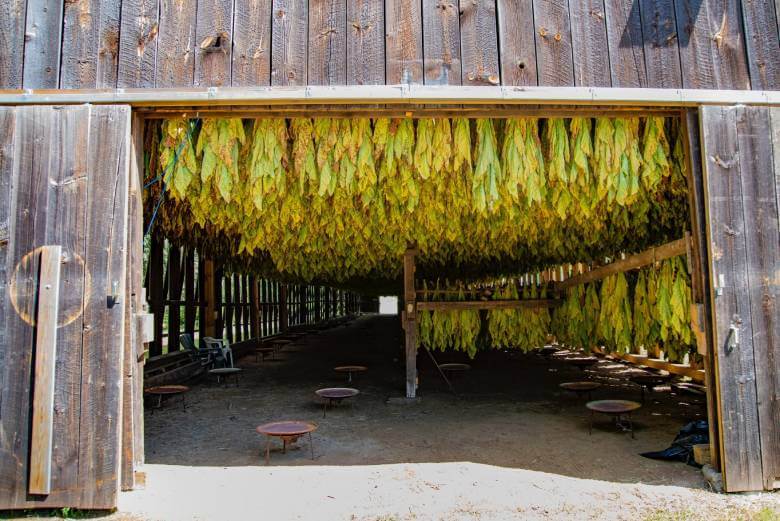
Ethical Considerations
08In other parts of the world, tobacco is widely accepted as a medicinal plant. Its role in spiritual practice is very diverse, and care should be taken to approach these traditions respectfully.
Cultural Ethics
Cultural ethics around tobacco change from place to place, and stem from how tobacco is used. If asking for advice or seeking assistance from an indigenous elder or knowledge keeper, it is appropriate to make an offering: this may take the form of tobacco, coca, or another plant, depending on the culture.
It is polite to follow the regional practices as best you can, and it is recommended to identify these practices as best as possible.
In Western countries, the ethical expectation is to not smoke around children or pregnant women; this extends to people who are not smokers, unless permission is given otherwise or there is a designated smoking area. These ethical considerations are often not found in other regions.
Common Misconceptions
09Nicotine is the major toxic ingredient in tobacco:
While nicotine is the compound that results in addiction, there are other substances that cause the most harm. There are approximately 7,000 toxins and harmful chemicals in tobacco, particularly tar and carbon monoxide [15], [16], [17]. There are 70 known cancer-causing chemicals in tobacco smoke [18].
Smoking causes permanent damage:
Yes, it’s true that habitual smoking results in damage, and this guide is not intended to promote chronic tobacco smoking. However, it’s worth noting that the damage from smoking can improve quickly after quitting, regardless of age. The risk of having a heart attack falls by 50% after about three years of smoking cessation. In the case of lung cancer, an ex-smoker’s risk drops to half after 10 years of cessation [19].
FAQ
10Why is tobacco used as an offering?
The idea of making an offering is ancient, almost archetypal: it is a way of giving thanks to the earth or the creator; to share something of value is a sign of respect. Offerings are made when asking for help, guidance, or protection. This same idea turns up in many other cultures, where offerings can take the form of food, alcoholic beverages, or plant material.
How do you bless tobacco?
Blessing tobacco can be done before you smoke it: say a prayer, hold it close to your heart, then light it, breathe it in, and blow it out without inhaling. Tobacco can also be blessed with prayer. With the introduction of Christianity into North and South America, tobacco has been blessed using rosaries in churches.
How do you present ceremonial tobacco?
Offer tobacco when seeking assistance from an indigenous elder or knowledge keeper. This may be when asking for indigenous knowledge, advice, a prayer, teaching, or a song. The offering of tobacco is a custom shared by many indigenous groups, and for many reasons in many different contexts.
How do you tie tobacco?
Tobacco can sometimes be offered in the form of a small bundle, referred to as a tobacco tie. This is done using a piece of fabric colored red, yellow, white, green, purple, or blue. The material is cut into the shape of a square (4 inches by 4 inches). A small amount of tobacco is placed in the center of the square, and the cloth is then folded together from the edges. The bundle is then tied with a piece of string or a strip of the fabric used to make the tie. A tobacco tie is an easy way of offering tobacco [20].
What are some uses of tobacco other than smoking?
Tobacco is used in various ways: as an offering, smudging, insufflation (as snuff), as an enema, or chewed. Tobacco can be used medicinally through oral consumption, inhalation, or as a poultice.
References
11[2] Motohiro, T., & John, E. C. (2005) NEONICOTINOID INSECTICIDE TOXICOLOGY: Mechanisms of Selective Action. https://doi.org/10.1146/annurev.pharmtox.45.120403.095930
[3] https://archive.org/details/earlyusesofcalif00ball
[4] https://psychonautwiki.org/wiki/Nicotine
[5] https://pubchem.ncbi.nlm.nih.gov/compound/Nicotine
[6] Pomerleau OF, Pomerleau CS (1984). Neuroregulators and the reinforcement of smoking: Towards a biobehavioral explanation. Neuroscience and Biobehavioral Reviews, 8:503-513.
[7] Pomerleau OF, Rosecrans J (1989). Neuroregulatory effects of nicotine. Psychoneuroendocrinology 14:407-423.
[8] https://cancercontrol.cancer.gov/sites/default/files/2020-06/m9_3.pdf
[9] https://echa.europa.eu/documents/10162/31694def-b7c3-208d-5aaf-3db9681ec3b9
[10] https://www.ncbi.nlm.nih.gov/pmc/articles/PMC3880486/
[11] https://www.rcplondon.ac.uk/projects/outputs/nicotine-without-smoke-tobacco-harm-reduction
[13] https://www.ncbi.nlm.nih.gov/pmc/articles/PMC3905555/
[14] https://web.archive.org/web/20110809165620/http://www.tc.columbia.edu/centers/cifas/drugsandsociety/background/chronologydruguse.html
[15] U.S. Department of Health and Human Services. The Health Consequences of Smoking—50 Years of Progress: A Report of the Surgeon General, 2014. Atlanta, GA: U.S. Department of Health and Human Services, Centers for Disease Control and Prevention, National Center for Chronic Disease Prevention and Health Promotion, Office on Smoking and Health, 2014.
[16]U.S. Department of Health and Human Services. How Tobacco Smoke Causes Disease: The Biology and Behavioral Basis for Smoking-Attributable Disease: A Report of the Surgeon General. Atlanta, GA: U.S. Department of Health and Human Services, Centers for Disease Control and Prevention, National Center for Chronic Disease Prevention and Health Promotion, Office on Smoking and Health, 2010.
[17] National Toxicology Program. Tobacco-Related Exposures. In: Report on Carcinogens. Fourteenth Edition. U.S. Department of Health and Human Services, Public Health Service, National Toxicology Program, 2016.
[18] https://www.cancer.org/cancer/cancer-causes/tobacco-and-cancer/carcinogens-found-in-tobacco-products.html
[19] https://www.who.int/news-room/questions-and-answers/item/tobacco-health-benefits-of-smoking-cessation
[20] https://carleton.ca/indigenous/policies-procedures/tobacco-offering-protocol/
Other references
BEYER, S.V. (2010). Singing to the Plants: A Guide to Mestizo Shamanism in the Upper Amazon. University of New Mexico Press.
BOWDEN, P. (2017). Smudging and Sacred Smoke. In: Entheogenesis Australis Journal 4 (Edited by Barlow, C.)
DOLOSWALA, K.N. (2017). The Nature of Plant Sacredness: Mapacho and the Wasps. In: Entheogenesis Australis Journal 4 (Edited by Barlow, C.)
OTT, J. (1993). Pharmacotheon: entheogenic drugs, their plant sources and history. Kennewick, WA, Natural Products Co.
RÄTSCH, C. (2005). The encyclopedia of psychoactive plants: ethnopharmacology and its applications. Rochester, Vt, Park Street Press
SCHULTES, R. E., & HOFMANN, A. (1992). Plants of the gods: their sacred, healing, and hallucinogenic powers. Rochester, Vermont, Healing Arts Press.
VOOGELBREINDER, S. (2009). Garden of Eden.
Download our FREE guide to learn how to begin a microdosing regimen, calibrate your dose level, and get the most out of your experience. “This FREE Guide was just what I needed to take the first step into Microdosing. AND IT WAS THE BEST DECISION OF MY LIFE! After starting my microdosing regiment I now have more focus, energy and clarity into what it is I truly want in this world.” Download our FREE guide to learn how to begin a microdosing regimen, calibrate your dose level, and get the most out of your experience. Everything you need to know about Microdosing in one place
James, New York Everything you need to know about Microdosing in one place

